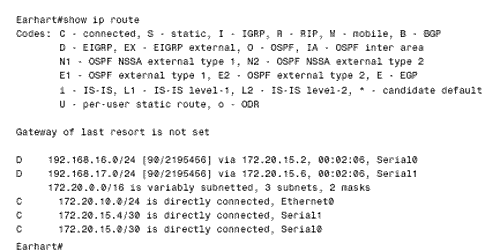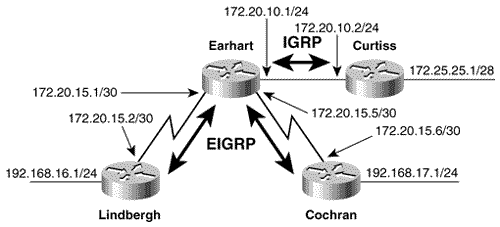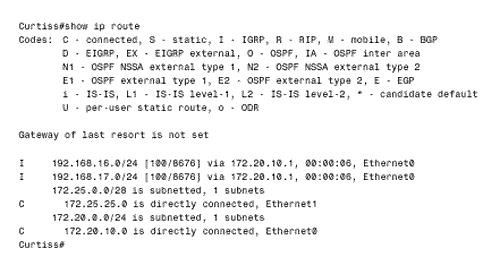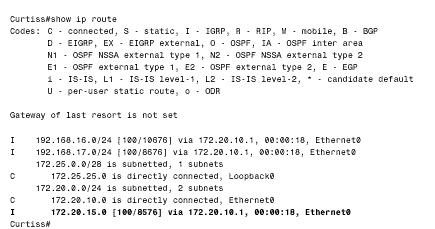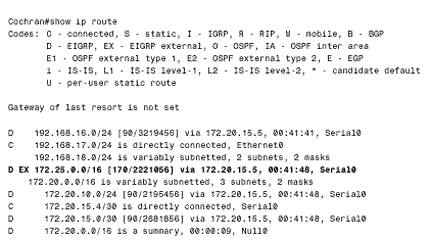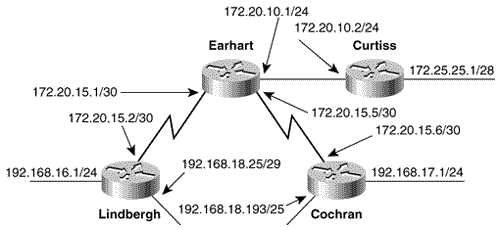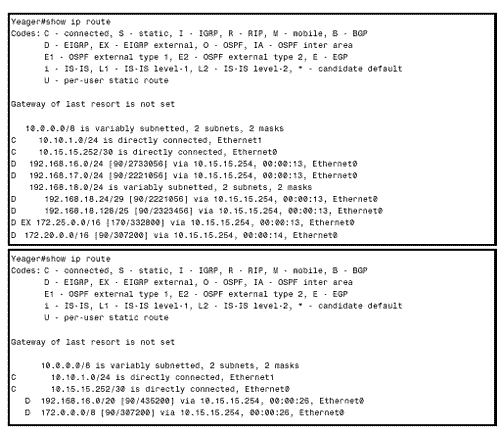Configuring EIGRP
| The basic configuratio n of EIGRP is so similar to the basic configuration of IGRP that instructors occasionally will instruct beginners to "configure IGRP, but add an E ." As mentioned in the previous section, the metric weights command is used the same way with EIGRP and IGRP. The traffic-share and variance commands are also used identically. For a review of these commands, please refer to Chapter 6. The case studies in this section demonstrate a basic EIGRP configuration and then examine summarization techniques and interoperability with IGRP. Case Study: A Basic EIGRP ConfigurationLike IGRP, EIGRP requires only two steps to begin the routing process:
The process ID may be any number between 1 and 65535 (0 is not allowed), and it may be arbitrarily chosen by the network administrator, as long as it is the same for all EIGRP processes in all routers that must share information. Alternatively, the number may be an InterNIC-assigned autonomous system number. Figure 8.36 shows a simple internetwork; the configurations for the three routers are as follows : Earhart:
Cochran:
Lindbergh:
Figure 8.36. Unlike IGRP, EIGRP will support the VLSM requirements of this internetwork. Earhart's route table is shown in Figure 8.37. The table shows that the default EIGRP administrative distance is 90 and that network 172.20.0.0 is variably subnetted . Figure 8.37. Earhart's route table. The internetwork of Figure 8.36 uses default metrics, unlike the earlier examples in this chapter, so a review of the EIGRP metric calculation in a more realistic scenario may be useful. Tracing the route from Earhart to network 192.168.16.0, the path traverses a serial interface and an Ethernet interface, each with default metric values. The metric calculation is the same as for IGRP, as discussed in Chapter 6, except that EIGRP will multiply the final result by 256. The minimum bandwidth of the route will be that of the serial interface, [15] and the delay will be the sum of the two interface delays. Referring back to Table 6.1:
Therefore,
Case Study: Redistribution with IGRPRedistribution between routing protocols is covered in Chapter 11, but it is worth noting here that if an IGRP process and an EIGRP process have the same process IDs, they will redistribute automatically. In Figure 8.38, router Curtiss has the following configuration:
Figure 8.38. If Earhart is configured with both EIGRP and with IGRP, using the same process ID for both, route information will be redistributed. Earhart is configured as follows:
The IGRP process speaks to Curtiss, and the EIGRP process speaks to Lindbergh and Cochran. Note that because Earhart's interfaces are all in network 172.20.0.0, the passive-interface command is used to restrict unnecessary routing protocol traffic. For EIGRP, this command is only needed to block unnecessary Hellos. If no neighbors are found on an interface, no other EIGRP traffic will be sent. Figure 8.39 shows Curtiss's route table. Notice that not only are routes to 192.168.16.0 and 192.168.17.0 present, but the metrics have been adjusted by the redistribution process to remove the EIGRP multiplier . Conversely, the metrics of routes redistributed into EIGRP from IGRP will be multiplied by 256. Figure 8.39. The route table in Curtiss after the IGRP process is added to Earhart. Figure 8.39 also shows that information is missing. Earhart's classful IGRP process will not accept the variably subnetted routes to 172.20.15.0/30 and 172.20.15.4/30. Using the command ip summary-address eigrp , Earhart can be configured to send a summary advertisement to Curtiss:
Curtiss's IGRP process will read the EIGRP summary, resulting in the route table shown in Figure 8.40. Figure 8.40. With Earhart configured to send a summary route, Curtiss can now reach the two serial links. Figure 8.41 shows Cochran's route table with the redistributed IGRP route. As this table shows, EIGRP explicitly tags externally learned routes. This information can be an aid when reading a route table because routes learned by redistribution are easily recognized. Figure 8.41. EIGRP tags externally learned routes, as Cochran's route table shows. Also of interest in Figure 8.41 is the last entry, a summary route pointing to the Null interface. This route helps to prevent potential black holes when default and summary routes are used. The technique is discussed in Chapters 11 and 12. Case Study: Disabling Automatic SummarizationBy default, EIGRP summarizes at network boundaries as do the protocols covered in previous chapters. Unlike those protocols, however, EIGRP's automatic summarization can be disabled. Figure 8.42 shows a situation in which disabling summarization is useful. Figure 8.42. Disabling automatic summarization at Cochran and Lindbergh prevents ambiguous routing to network 192.168.18.0. New Ethernet links have been added to routers Cochran and Lindbergh, and their addresses create a discontiguous subnet. The default behavior of both routers is to see themselves as border routers between major networks 172.20.0.0 and 192.168.18.0. As a result, Earhart will receive summary advertisements to 192.168.18.0 on both of its serial interfaces. The result is an ambiguous routing situation in which Earhart records two equal-cost paths to 192.168.18.0; a packet destined for one of the subnets may or may not be routed to the correct link. Automatic summarization is turned off with the command no auto-summary . For example, Lindbergh's configuration will be:
By turning off summarization at Lindbergh and Cochran, the individual subnets 192.168.18.24/29 and 192.168.18.128/25 will be advertised into network 172.20.0.0, eliminating the ambiguities at Earhart. Case Study: Address AggregationA new router is added to the internetwork in Figure 8.43. The five network addresses that Earhart must advertise to Yeager can be summarized with two aggregate addresses. Earhart's configuration will be:
Figure 8.43. Earhart is advertising two aggregate addresses to Yeager. The ip summary-address eigrp command will automatically suppress the advertisement of the more specific networks to Yeager. Figure 8.44 shows the route table of Yeager before and after the aggregate addresses are configured. Even in this small internetwork, the number of EIGRP-learned entries has been reduced by half; in a large internetwork, the impact on route tables and the memory required to store them can be significant. Figure 8.44. Yeager's route table before and after aggregate addresses are configured at Earhart. AuthenticationAuthentication of EIGRP packets is supported in IOS versions 11.3 and later. MD5 cryptographic checksums are the only authentication supported, which on first consideration may seem less flexible than RIPv2 and OSPF, which support both MD5 and clear-text passwords. However, clear-text password authentication should be used only when a neighboring device does not support the more secure MD5. Because EIGRP will be spoken only between two Cisco devices, this situation will never arise. Note Authentication method of EIGRP compared to OSPF and RIPv2 The steps for configuring EIGRP authentication are:
Key chain configuration and management are described in Chapter 7. EIGRP authentication is enabled and linked to a key chain on an interface with the commands ip authentication key-chain eigrp and ip authentication mode eigrp md5 . [16]
Referring to Figure 8.43, the following configuration enables EIGRP authentication on Cochran's interface to Earhart: Cochran
A similar configuration would be necessary on Earhart. The commands accept-lifetime and send-lifetime are used for key chain management as described in Chapter 7. |

